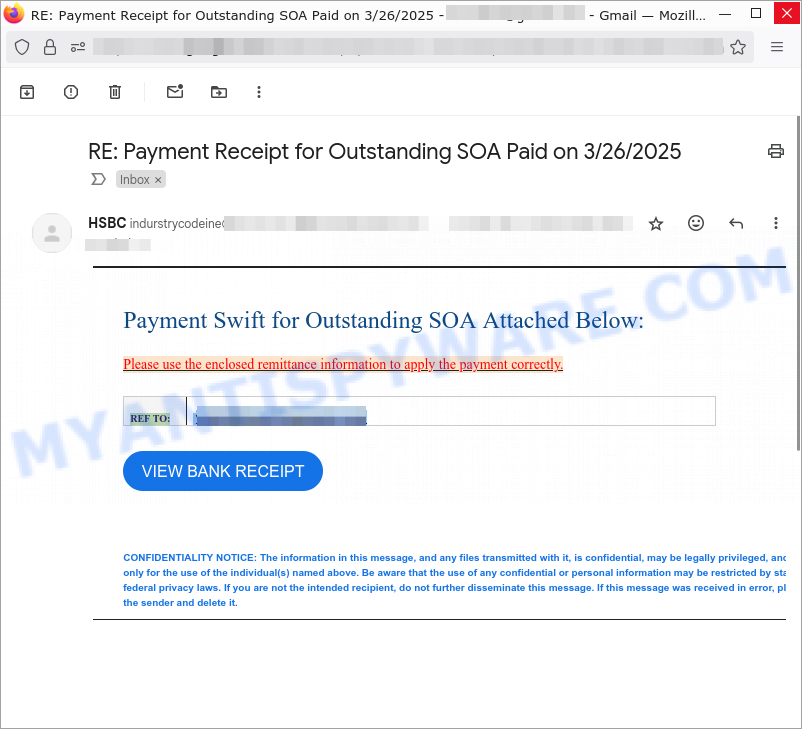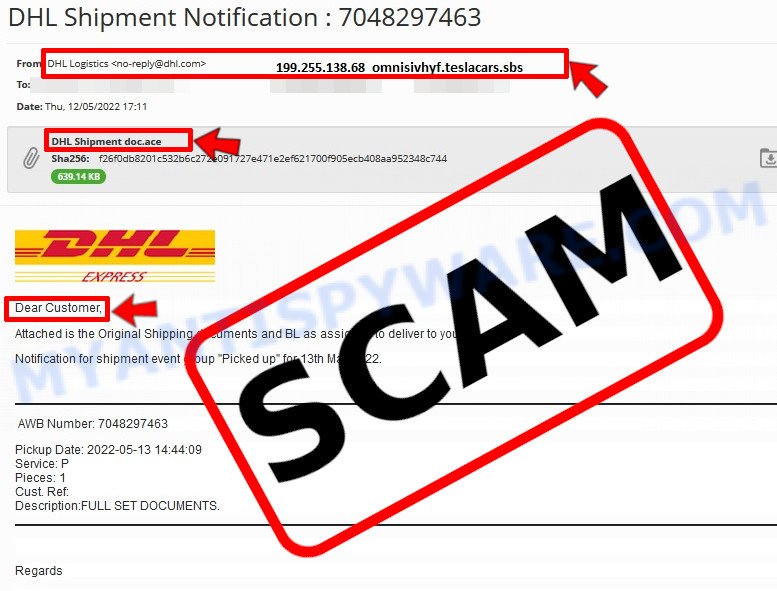Have you received an email claiming to be from HSBC with a subject line like “RE: Payment Receipt for Outstanding SOA Paid on 3/26/2025” and a suspicious-looking sender email address, like indurstrycodeine@xxxxx?

Question: Is this email real or safe to engage with?
Investigation Findings: The email is a scam. The sender’s address is not a typical HSBC email address and the “VIEW BANK RECEIPT” link provided leads to a phishing page, tricking you into entering personal information.
Answer: The HSBC Payment Receipt is a fraudulent email attempt. 💡 To protect yourself from scams like this, always check the email address closely and be wary of unfamiliar email senders. Never click on links or download attachments from unknown sources. Additionally, contact the bank directly using their official contact details if you are unsure about the authenticity of an email.
A typical “HSBC Payment Receipt” scam email reads as follows:
Subject: RE: Payment Receipt for Outstanding SOA Paid on 3/26/2025
From: HSBC indurstrycodeine@xxxxx
Body:
“Payment Swift for Outstanding SOA Attached Below:Please use the enclosed remittance information to apply the payment correctly.
REF TO: xxx@xxxxxxxx.com
VIEW BANK RECEIPTCONFIDENTIALITY NOTICE: The information in this message, and any files transmitted with it, is confidential, may be legally privileged, and intended only for the use of the individual(s) named above. Be aware that the use of any confidential or personal information may be restricted by state and federal privacy laws. If you are not the intended recipient, do not further disseminate this message. If this message was received in error, please notify the sender and delete it. “
The HSBC Payment Receipt Email is a scam that targets people by sending fake emails that look like they are from HSBC, a bank. These emails pretend to provide a payment receipt, tricking recipients into thinking it’s official. The email usually emphasizes urgency, like paying an outstanding balance.
These scam emails often have a subject like “RE: Payment Receipt for Outstanding SOA Paid”, and they’re sent from an address that seems close to HSBC but isn’t. Inside the email, there’s a misleading link labeled as “VIEW BANK RECEIPT”. Clicking this link doesn’t show a receipt; instead, it takes you to a bogus site set up to steal your personal information (also known as phishing).

Scammers send these emails to many people at once, hoping someone will believe it and click. They take advantage of how emails are easy to believably fake. If you get an email like this, don’t click any links or provide your information.
💡 If you get an email that seems suspicious, especially one asking for financial details or personal information, make sure to check its legitimacy by directly contacting the bank using official contact methods. Don’t use any contact info from the suspicious email. If you accidentally clicked, check your system for threats using reliable security software, and change your passwords just in case.
Summary Table
| Name | HSBC Payment Receipt Email Scam |
| Type | Email Phishing |
| Sender | indurstrycodeine@xxxxx |
| Target | HSBC Customers |
| Link | Phishing page on IPFS cloud hosting |
📧 What to Do When You Receive the “HSBC Payment Receipt” Scam Email
We advise everyone who receives this email to follow the simple steps below to protect yourself from potential scams:
- ❌ Do not believe this email.
- 🔒 NEVER share your personal information and login credentials.
- 📎 Do not open unverified email attachments.
- 🚫 If there’s a link in the scam email, do not click it.
- 🔍 Do not enter your login credentials before examining the URL.
- 📣 Report the scam email to the FTC at www.ftc.gov.
If you accidentally click a phishing link or button in the “HSBC Payment Receipt” Email, suspect that your computer is infected with malware, or simply want to scan your computer for threats, use one of the free malware removal tools. Additionally, consider taking the following steps:
- 🔑 Change your passwords: Update passwords for your email, banking, and other important accounts.
- 🛡️ Enable two-factor authentication (2FA): Add an extra layer of security to your accounts.
- 📞 Contact your financial institutions: Inform them of any suspicious activity.
- 🔄 Monitor your accounts: Keep an eye on your bank statements and credit reports for any unusual activity.
🔍 How to Spot a Phishing Email
Phishing emails often share common characteristics; they are designed to trick victims into clicking on a phishing link or opening a malicious attachment. By recognizing these signs, you can detect phishing emails and prevent identity theft:

💡 Here Are Some Ways to Recognize a Phishing Email
- ✉️ Inconsistencies in Email Addresses: The most obvious way to spot a scam email is by finding inconsistencies in email addresses and domain names. If the email claims to be from a reputable company, like Amazon or PayPal, but is sent from a public email domain such as “gmail.com”, it’s probably a scam.
- 🔠 Misspelled Domain Names: Look carefully for any subtle misspellings in the domain name, such as “arnazon.com” where the “m” is replaced by “rn,” or “paypa1.com,” where the “l” is replaced by “1.” These are common tricks used by scammers.
- 👋 Generic Greetings: If the email starts with a generic “Dear Customer”, “Dear Sir”, or “Dear Madam”, it may not be from your actual shopping site or bank.
- 🔗 Suspicious Links: If you suspect an email may be a scam, do not click on any links. Instead, hover over the link without clicking to see the actual URL in a small popup. This works for both image links and text links.
- 📎 Unexpected Attachments: Email attachments should always be verified before opening. Scan any attachments for viruses, especially if they have unfamiliar extensions or are commonly associated with malware (e.g., .zip, .exe, .scr).
- ⏰ Sense of Urgency: Creating a false sense of urgency is a common tactic in phishing emails. Be wary of emails that claim you must act immediately by calling, opening an attachment, or clicking a link.
- 📝 Spelling and Grammar Errors: Many phishing emails contain spelling mistakes or grammatical errors. Professional companies usually proofread their communications carefully.
- 🔒 Requests for Sensitive Information: Legitimate organizations typically do not ask for sensitive information (like passwords or Social Security numbers) via email.
✅ Conclusion
We hope this article has helped you understand more about the “HSBC Payment Receipt” Scam Email and how to avoid falling victim to scammers. If you have received a phishing email that is similar but not identical to the example above, please post it in the comments section of this article. This helps us warn other users about potential scams and improve our resources to protect you better. Stay safe and vigilant! 🛡️















